Newsletter 120
31/08/15
Creative conservation
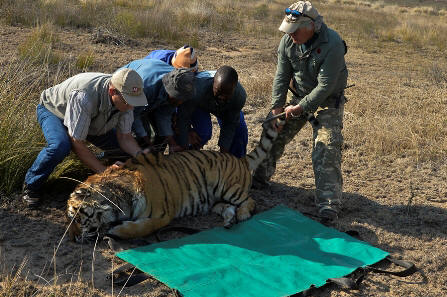
When I darted my first lion in the 70's,
things were very different. Dart guns were much less accurate
than they are today. The darts were heavy metal and aluminium.
(On one occasion the metal dart killed a cheetah outright on
impact.) Today, a good vet can hit a small target at 40 metres
with a modern dart gun.
In the 70's there was no antidote for lions.
I remember staying up many nights protecting sleeping lions that
were recovering from being darted. With an antidote, a lion or
tiger can be fully awake in 5 to 10 minutes.
In those days we used a drug called Sernyl or
Phencyclidine. (This drug was abused by the drug users in
America and was called "Angel Dust". It caused hallucinations in
humans).
Occasionally a lion darted with Sernyl would
go into a fit. We would put cardboard between its teeth to
prevent it biting it's tongue.
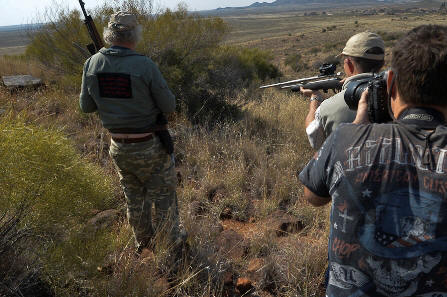
This last week at Tiger Canyons, Dr Ryan
Nienaber and Dr Charlotte Mouiex expertly moved 5 tigers and put
3 tigresses on birth control. All of this in the space of a few
hours.
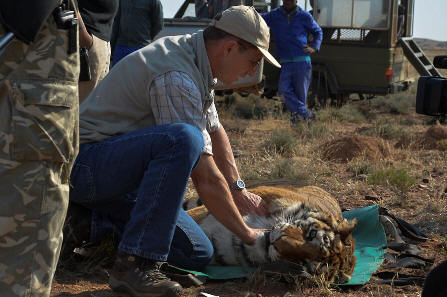
The introduction of contraception is hugely
useful in a project like Tiger Canyons, where the numbers have
to be carefully managed.
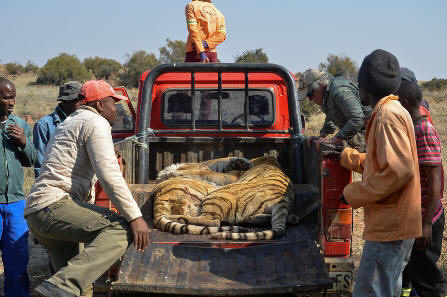
Once the tiger is darted, I am able to insert
a microchip (this is for identification), place a satellite
transmitter under the skin (this is a device which allows us to
track the tiger and map it's home range), take a blood sample
(this allows us for create a genetic profile of each tiger).
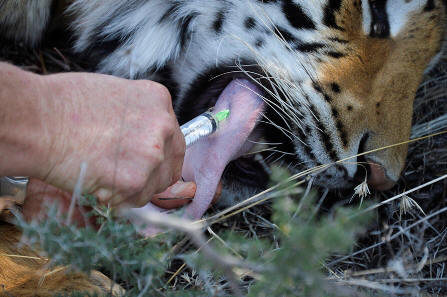
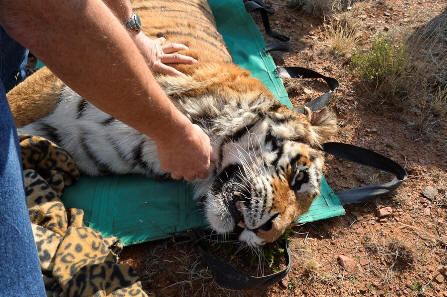
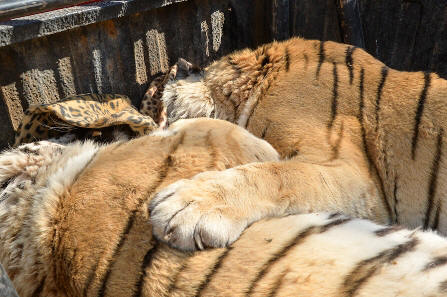
The management plan to create one large area
for tigers has begun and the first internal fence (5km long) is
being removed as I write this.
This means that Ussuri's 3 cubs, Antoine,
Jameez, and Marguerite have a large area into which they can
disperse. Ussuri and Tibo (the white tigress) are now able to
greatly expand their territories.
In theory Tibo's three cubs could be in
danger from males that are not the father. However Shy Boy,
Tiger Boy, and Seatao have all been moved to other areas.
On moving Tiger Boy into Corbett's area, he
immediately attacked Zaria's cubs. Zaria defended her cubs and a
fight broke out. Corbett on hearing the fight, joined Zaria and
attacked Tiger Boy. Tiger Boy got Corbett down and was winning
the fight when Zaria jumped onto Tiger Boy and attacked him,
saving Corbett's life. (I witnessed a similar incident in a
fight between two male leopards, Marthly Male and Camp Pan Male.
Vomba female jumped onto Marthly Male to help Camp Pan Male out
who was the father of her cubs.) After Zaria jumped onto Tiger
Boy, all three tigers began boxing and I witnessed the
incredible sight of 3 tigers, all a metre off the ground
captured in one frame.
While the adults were fighting, Zaria's cubs
ran away but got separated. Tiger Boy killed one of the cubs the
following morning.
I would like to thank the following people
who have over many years shared their knowledge of veterinary
care and management of big cats with me.
The late Dr Eddie Young and Dr David Meltzer.
Doctors Roy Bengis, DeWald Keet, Peter Rodgers, Charlotte Mouiex
and Ryan Nienaber. In addition Ian Whyte, Butch Smuts, Trevor
Dealove.
Tread lightly on the Earth
JV
Serengeti Highway
I would like to congratulate the African
Network for Animal Welfare (ANAW) who had the courage to take
the Tanzanian Government to court and prevent, for now, the
highway through the Serengeti being built.
The East African Court of Justice ruled
against a paved commercial highway through Serengeti
National Park in Tanzania. Although a great victory, the
ruling contains ‘potholes.’
Serengeti Watch supported a court case
brought forward by the African Network for Animal Welfare (ANAW),
a nonprofit organization located in Kenya, who filed for the
case in December of 2010. We provided funding through its
Serengeti Legal Defense Fund which paid for research trips
to the Serengeti and legal fees for the Kenyan attorney,
Saitabao Ole Kanchory.
The suit was filed after the government
of Tanzania announced plans to build a 53 Km commercial
highway across the northern section of the Serengeti
National Park. The highway would replace an existing dirt
track. According to a Tanzanian government study the highway
would carry up to 800 commercial vehicles a day by 2015,
with increasing numbers thereafter. Scientists warned that
the highway would bisect a narrow section of the Serengeti
ecosystem that was critical to the annual wildebeest
migration. Therefore, the proposed highway would cause the
migration to collapse due the fragmentation of natural
migration patterns.
The lawsuit sought a permanent injunction
against the proposed highway on the grounds that it was in
violation of the East African Community Treaty, of which
Tanzania and Kenya are signatories. The Treaty calls for
“the promotion of sustainable utilization of the natural
resources of the Partner States and the taking of measures
that would effectively protect the natural environment of
Partner States.” The applicant sought to bar Tanzania from
“upgrading, tarmacking, paving, realigning, constructing,
creating or commissioning” the existing track.
Serengeti Watch and ANAW contended that
opening a paved highway to the general public would cause
irreversible damage to the Serengeti. The highway would
impact: migratory species such as zebras and wildebeest;
wildlife poaching; air quality and noise; soils; flora and
fauna; road safety and increased accidents as well as many
more unforeseen issues. ANAW cited conservation
organizations that had issued warnings about the impact of
the highway, including the UNESCO World Heritage Committee.
The case also contended that the
government of Tanzania was in violation of various
international treaties. Chief among these, a UNESCO treaty
declaring the Serengeti a “World Heritage Property” of
“outstanding universal value.
The court agreed with the plaintiff’s
argument that the highway would have irreversible negative
impacts. It affirmed that construction of the highway would
be a violation of the East African Community Treaty. In
doing so, the court order cited Tanzania’s own Environmental
Impact Study and relied heavily on statements issued by the
UNESCO World Heritage Committee.
“A permanent injunction is hereby issued
restraining the Respondent from going forward with its
initial proposal of constructing or maintaining a road of
bitumen standard across the Serengeti National Park subject
to its right to undertake such other programs or initiate
policies in the future which would not have a negative
impact on the environment and ecosystem in the Serengeti
National Park.” Read the court verdict.
After the verdict ANAW’s Executive
Director, Jophat Ngonyo, said: “This was not a win for ANAW;
nor for our lawyer, Saitabao Ole Kanchory, not for Serengeti
Watch, not for our expert witness John Kuloba, but for the
millions of animals in the Serengeti-Mara ecosystem. It is a
win for nature and God’s creation. Nature has won today.”
A road upgraded is still in the
pipeline:
Although, the case sought to prevent any
form upgrading, the court did not specifically bar this,
only the development of an asphalt road. The government of
Tanzania says it will instead upgrade the existing dirt
track to an all-weather gravel road. The track is in a zone
designated to wilderness area, reserved for park vehicles
and walking safaris.
Roads for public use not addressed:
The EACJ said that roads in the Serengeti
should be “reserved for tourists and park personnel and not
the general public,” its injunction did not specify this.
Tanzania still has the ability to open roads for the public,
including commercial use. In fact, in a recent press
article, government officials have emphasized their
intention to build a highway that would inevitably cross the
park.
Roads outside of the park not addressed:
The entire Serengeti ecosystem includes
areas within the Serengeti National Park and outlying areas
such as the Masai Mara. Wildlife migration takes place
across all these regions. There are plans for paved roads in
migration areas outside the park that will impact the
migration. The court case did not address this issue either.
Many observers warn that the gravel road
will inevitably become a highway carrying more commercial
traffic. There will be increasing pressure to connect the
paved roads on either side of the park with a commercial
link through the park. Richard Leakey, for one, said that a
highway is “inevitable.”
Sale of Zimbabwe Elephants to Chinese
I would like to thank all of you who have
kept exposing the despicable sale of 200 elephant calves to
China.
Keep the pressure up in the social media and
keep asking the question, how is it that CITES have granted
permits for these elephants.
Controversial Export of Elephants to China
Appears Under Way
A grim fate likely awaits young elephants
plucked from Zimbabwe's wild.
By Christina Russo, National Geographic
PUBLISHED Thu Jun 25 14:15:00 EDT 2015
Chinese crews in a Zimbabwe park are
reportedly preparing young elephants and lions captured there
for transport to China, triggering alarm among activists who
fear that the animals are doomed to a life of suffering.
Sources close to the scene have claimed that
the facility in Hwange National Park, where elephants have been
confined since late last year, has been turned over to the
Chinese.
According to Sharon Hoole, a Zimbabwe-born,
UK-based animal activist who has been closely following—and
protesting—the planned export of the Hwange elephants, “We were
pushing and asking [our sources] for photos, specifically of the
hydraulic equipment and the trucks and forklifts [brought to the
park], and we weren't getting feedback from our contacts.”
She says she found out on June 18 that most
of the Zimbabwean staff at the facility have been replaced by
Chinese workers and veterinarians.
Hoole was also told that the Chinese are
“rehearsing” loading elephants into their transportation crates
with bull hooks.
Training of wild-caught elephants involves
beating, chaining, food deprivation, and social deprivation.
Given what is now known about the high
intelligence of elephants and the importance of their social
bonds, ripping them from their herds and sending them across the
globe to be kept in prison-like conditions is deeply troubling
to those who know them intimately.
“For elephants, being held captive for
decades in a circus or in the majority of the world's zoos is
gruesome, a fate worse than death," Joyce Poole, the cofounder
of Kenya-based ElephantVoices, a research and advocacy
organization, told National Geographic.
Claims about the planned wildlife export are
almost impossible to verify, but news reports and information
pieced together from conservation groups, veterinarians,
citizens, and animal advocates suggest that some elephants are
now on the verge of being flown to China, where they may end up
in a safari park.
This murky saga began last November, when a
local wildlife organization, the Zimbabwe Conservation Task
Force (ZCTF), sent out an alert that 34 elephants, 7 lions, and
10 sable antelopes had been captured in Hwange and would be sent
to China.
But in December, Saviour Kasukuwere,
Zimbabwe’s environment minister, told National Geographic in an
email “We have not authorized any exports of elephants to
China.”
In January 2015, the Guardian reported that
Zimbabwe officials said the elephants, in fact,would be sent to
China and France.
In an email in February to National
Geographic, Meng Xianlin, of the CITES management authority in
China, denied that the elephants would be imported into his
country.
The French CITES authority also told National
Geographic that France had no plan to import the elephants.
In March, in an interview with National
Geographic, Kasukuwere said that the Hwange calves would be
relocated within Zimbabwe. But he also said that Zimbabwe
authorities were looking for buyers and that if they received an
“order,” they would export elephants accordingly.
More recently, in another U-turn, the
Telegraph reported that the elephants were destined for
Chimelong Safari Park. Kasukuwere told the Telegraph that the
elephants had been “tamed.”
Kasukuwere also said that after five years,
the elephants would return to “the forests of Zimbabwe.”
Ainsley Hay, with the National Council of
SPCAs, in South Africa, says that “almost all training of
wild-caught elephants involves breaking them using horrific
abuse, including beating, chaining, stretching, food
deprivation, and social deprivation.
“As these animals are destined for countries
that have poorly controlled animal-welfare standards,” Hay says,
“it’s safe to assume these calves will [have been] trained in
this manner.”
Following the story in the Telegraph,
National Geographic contacted minister Kasukuwere; Walter Mzembi,
the minister of tourism; Caroline Washaya-Moyo, a public
relations official at ZimParks; and Meng Xialin to substantiate
rumors as to the number of elephants, their destination, and the
timing and manner of their export. No responses were received
prior to publication.
How the elephants and lions will leave the
country is unclear.
One possibility is that they’ll be trucked to
the airport in nearby Victoria Falls, or perhaps the one in
Zimbabwe’s second city, Bulawayo. Or they could be flown
directly out of Hwange.
“The Hwange Game reserve airport is
functioning,” wrote David Coltart, senator with Zimbabwe’s
opposition party, the Movement for Democratic Change. “It is in
fact a long runway constructed with help from the U.S. a long
time ago as one of its strategic long range bases. It could
literally take a B52 bomber—it could easily take cargo
aircraft.“
Hoole says she has sources posted at all
these locations, waiting round-the-clock to document the
departure.
Any time elephants are transported by air,
there are great risks, says Richard Ruggiero, Africa branch
chief with the U.S. Fish and Wildlife Service.
“The challenges are: loading and unloading,
the level of tranquilizers that keep them calm (they are
stressed as hell during the operation), keeping them cool until
you reach altitude, keeping their breathe-way open (trunk), and
of course, they cannot move around and shift the center of
gravity during flight, particularly take-off and landing.”
Veterinarians and animal welfare groups in
Zimbabwe say they’ve made numerous attempts to stop the export
and have expressed their concerns to officials.
Melanie Hood is the animal welfare director
with Veterinarians for Animal Welfare Zimbabwe (VAWZ). She says
that since December 2014, her group—in conjunction with the
Society for the Prevention of Cruelty to Animals in Zimbabwe—has
sent several letters to the director general of the Parks and
Wildlife Management Authority requesting a meeting about the
young elephants. But “no reply has been received.”
Hood also says that groups have requested
permission to inspect the elephants, “together with people who
we deem to be 'elephant experts'—but again no official
confirmation or reaction to our request has been received. We
continue to try.”
Besides the Telegraph report, indications
that the elephants may indeed be destined for Chimelong Safari
Park can be found in an article published in April in Qingyuan
Daily News.
The report refers to the first phase of
construction of the Qingyuan ZhangLong animal quarantine station
having been completed and mentions plans to “import African
elephant in July 2015.”
Qingyuan is a prefecture-level city in
Guangdong province, where Chimelong, billed as “the largest
safari park housing the most species in the world,” is located.
David Neale, of Animals Asia, a Hong-Kong
based welfare organization that focuses on captive animal
issues, among other causes, notes that “many animals, including
elephants, are forced to perform demeaning and degrading tricks.
They are forced to do so under pressure from handlers with
handheld jab sticks. The circus performances are likely to cause
many animals at Chimelong Safari Park a degree of suffering.”
Chunmei Hu, who works at Nature University,
an environmental center in Beijing, says some of the elephants
will go to a park called Laodao Bay, in Zhangjiajie, a city in
Hunan Province.
Hu says the enclosures there are “so small”
and that the elephants will have to perform. “I think it has
terrible animal welfare.” She says she’ll monitor the elephants
if and when they arrive.”
In Zimbabwe, Jane High, one of the core group
campaigning against the China export, wrote that she’s been
“working with anybody and everybody trying to raise the profile
of the disaster happening to our wild life. We’ve been through a
lot here, but nothing has come so close to destroying my soul as
this wildlife trade.”